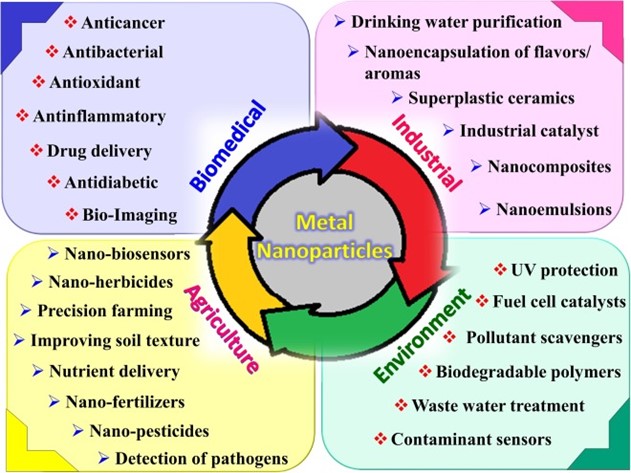
Figure: Applications of nanomaterials and nanotechnology in various sectors (Saratale, 2018)
Below are some of sectors which apply nanomaterials and nanotechnology:
Nanomedicine
In the modern world, cancer is one of the leading causes of death. Clinical uses of cancer chemotherapeutic medications are severely constrained by their poor water solubility, non-specific biological distribution, and reduced therapeutic impact. However, the innovative nano-drug delivery technology can address these drawbacks. Drugs and nanocarriers worked together to achieve controlled release, better targeting, and increased loading efficiency. The Food and Drug Administration has so far approved around 50 nanodrugs for use in treating various illnesses. In comparison to conventional chemotherapies, nanodrugs have a larger promise for treating diseases with more efficacy and fewer side effects. pH-sensitive nanocarriers that can cut off drug molecules and destroy cancer cells without harming healthy cells have been created using disulfide and hydrzone as the building blocks. Lipids (liposomes), polymers (macromolecules, micelles, or dendrimers), and viruses can all be used to create nanocarriers.
A design strategy for thick shell stabilised core-shell nanoparticles for deep drug administration was published by Chen XS, et al. For tissue penetration and cell absorption, a significant size decrease and charge reversal are advantageous. The shells are stacked by electrostatic force in a polypeptide modified with dimethylmaleic anhydride. The size of shell-stacked nanoparticles drastically decreased from 145 nanometers to 40 nanometers in the acidic microenvironment of tumour tissues, while the surface charge changed from -7.4 millivolts to 8.2 millivolts. Disintegration of the disulfide-linked nuclei in the cells speeds up intracellular drug release and improves anticancer efficacy. Antineoplastic medications can be delivered by this nanocarrier to deeper tumour locations.
Environment pollution
Ecosystem health is at risk due to the discharge of nanoparticles into the surrounding environment, which must be immediately addressed. Wet deposition, landfills, factories, and the use of products containing nanomaterials are among sources of nanoparticle emissions. Inorganic processes in organisms alter, accumulate, and degrade nanomaterial circulation. To remove pollutants from water and the air, metal and metal oxide nanoparticles have been utilised. Nanomaterials were used more frequently, which increased environmental discharges. By generating reactive oxygen species, inorganic nanomaterials like SiO2, TiO2, and ZnO produce high toxicity to microorganisms and have oxidative stress effects. Fullerene (C60) colloid also showed antimicrobial activity. Fullerene (C60) colloid exhibits oxidative stress impact, which can lead to severe lipid peroxidation in fish brain. The geochemical cycle is primarily driven by microbes, which are also the foundation of ecosystems and the food chain. In order to maintain the health of the environment, it is crucial to understand how nanomaterials and microbes interact. The ecological environment will be impacted by the creation and release of nanomaterials. The creation of nanomaterials releases metal ions that are extremely harmful to the environment.
Biosensors
On the surface of a medical microbiological sensor, biological components like antibodies, enzymes, and antigens were fixed as a part. A quantitative test of the presence or absence of a certain microorganism is accomplished by microorganisms precisely combining to the sensor surface and producing an electrical signal for detection. As highly conductive materials that can reinforce sensor electrodes and biological response centres, nano-metal compounds have numerous uses in microbial sensors. Chemical reactions go more quickly thanks to the electron transfer mechanism, which also boosts the sensor's sensitivity. In order to perform diagnosis and treatment, such biosensors might be injected into a patient's body and act as a carrier or a probe to gather more specific information about the patient's body. In order to create an Au nanoparticles-labeled antibody biosensor, carbon nanotubes were used as the substrate and nanospheres as the load. This method has a lower detection limit and a greater corresponding current than the traditional detection method.
References
Elprocus. (2022). What are Nanomaterials – Classification and Its Properties. Retrieved from https://www.elprocus.com/nanomaterials-classifications-and-its-properties/
Gorai, D. S. (2019, August 9). Introduction to Nanomaterials and Nanotechnology. Retrieved from https://agc.ac.in/resources/Introduction_to_Nanomaterials_and_Nanotechnology.pdf
Jayvadan K. Patel, A. P. (2021, June 24). Introduction to Nanomaterials and Nanotechnology. Retrieved from https://link.springer.com/chapter/10.1007/978-3-030-50703-9_1
Rizwan, A. S. (2021). Chapter 3 - Types and classification of nanomaterials. Retrieved from https://www.sciencedirect.com/science/article/pii/B978012823823300001X
Nanowerk. (2022). What are Nanomaterials? Retrieved from https://www.nanowerk.com/what-are-nanomaterials.php
Vladimir Pokropivny, R. L. (2007). Introduction to Nanomaterials and Nanotechnology. Retrieved from https://www.researchgate.net/profile/Alex-Pokropivny/publication/299345334_Introduction_in_nanomaterials_and_nanotechnology/links/56f160e008ae1cb29a3d0c2d/Introduction-in-nanomaterials-and-nanotechnology.pdf
Zhang, L. (2019, June 27). Applications, Challenges and Development of Nanomaterials and Nanotechnology. Retrieved from https://jcsp.org.pk/PublishedVersion/f7845589-394c-478e-aae3-4346169943f4Manuscript%20no%203,%20Final%20Galley%20 Proof%20of%2012199%20(Ling%20Zhang).pdf
Written by,
Nurintan binti Jamil, Internship Student, Nanomaterials Synthesis and Characterization Laboratory (NSCL), ION2 &
Dr. Mohd Hafizuddin Ab Ghani, Research Officer, Nanomaterials Synthesis and Characterization Laboratory (NSCL), ION2
Date of Input: 30/09/2022 | Updated: 07/10/2022 | roslina_ar
MEDIA SHARING























